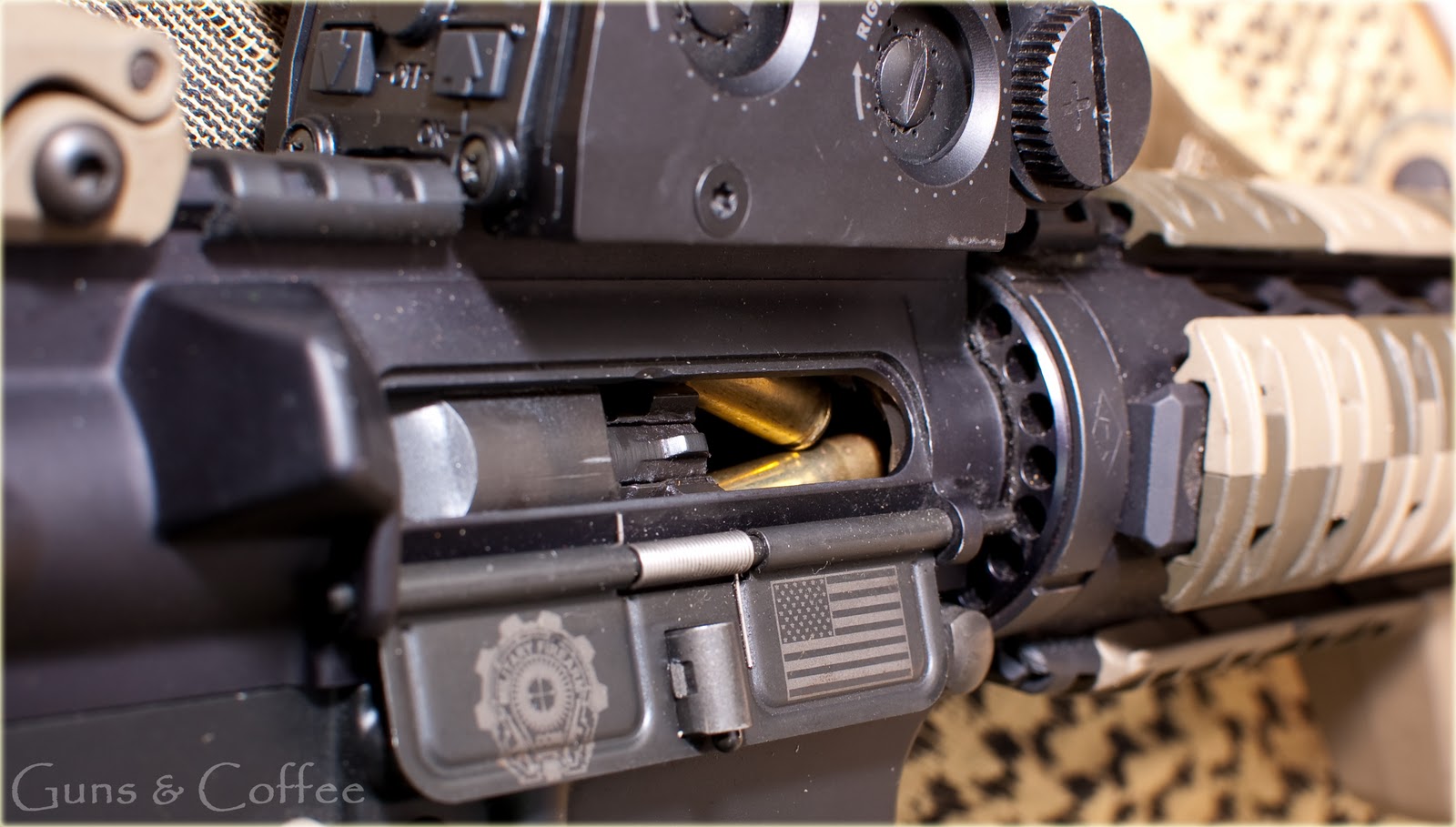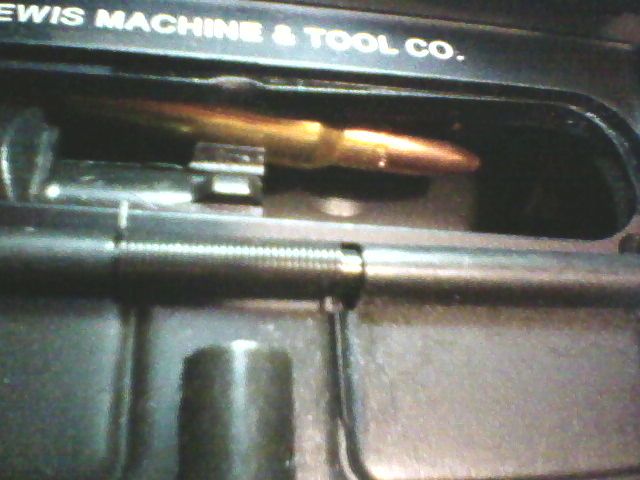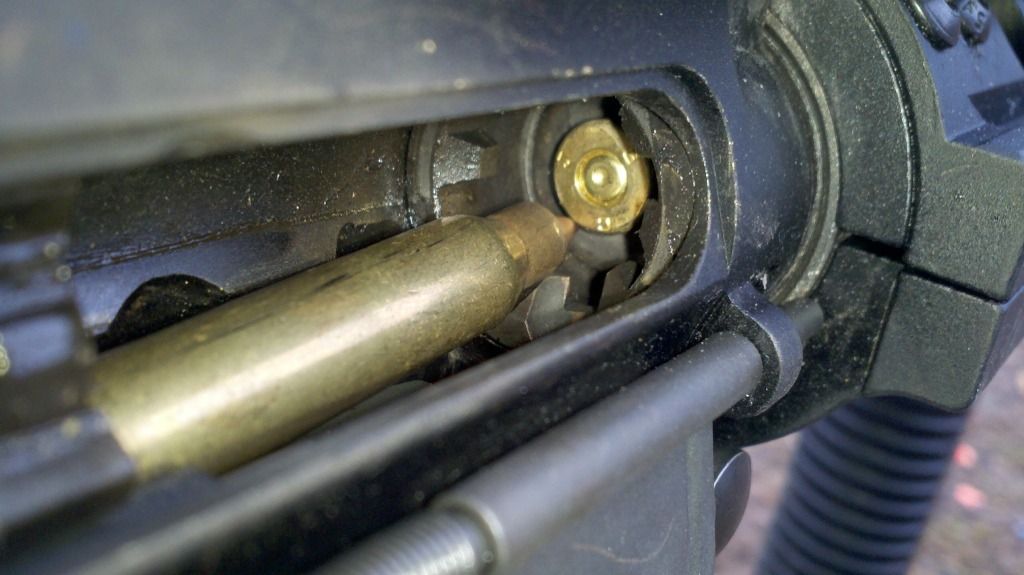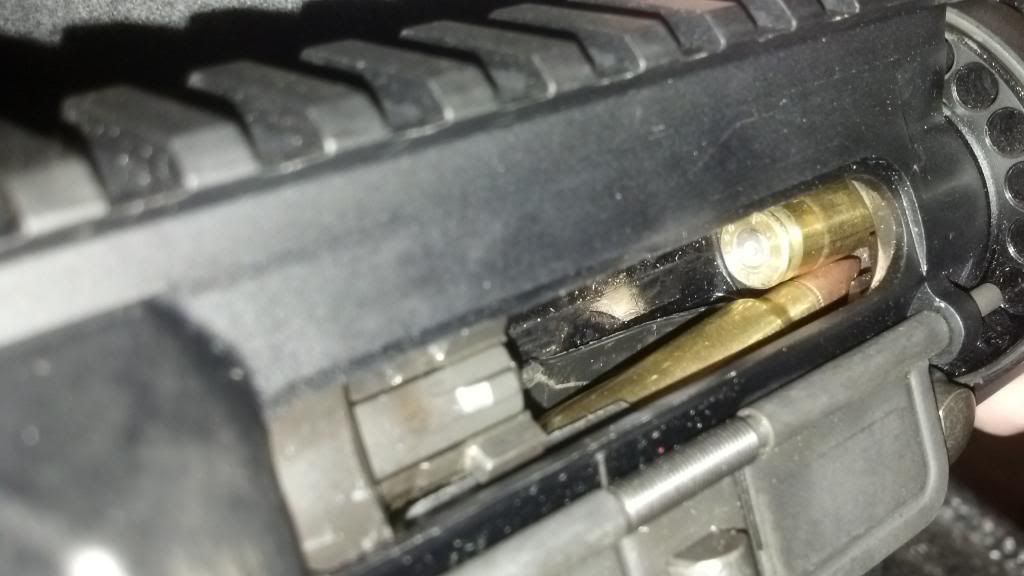|
|
Post by Erick on Dec 3, 2016 22:48:22 GMT -5
Ok some time ago... I've gotten reasonably competent on bolt-overrides and they are still part of what I teach USAF or Navy guys from my work (who often have zero M4/M16/AR15 exposure)
However.... I've been doing some thinking...
Took a pretty good class from a guy who only treated in in passing (was a one day class anyhow , pretty good class from a gunfighting perspective, which IMO is not the Alpha and Omega training paradigm but its the most common one and I have hardly ever taken those compared to SUT classes + it was fun) ..
But the fact he treated it in passing got me thinking .....and a remark by another student (who BTW was kinda douche in general... acted like the worlds gift to shooting.. didn't outshoot me once though, plus way fatter than I am but clearly not making up for it with core and leg strength), this remark was: .."I've never seen bolt overrides in a semiauto, ever."
This is something that had never occurred to me before... yet it makes sense...
Sooo.... I am thinking.. since my Operational Concept involves the exclusive use of semi-auto fire arms (even if i had afull auto which I dont...for ammo management purposes SHTF and all that..., anywho the full auto capability is IMO a bit of a niche that can only be exploited by those backed up by a .gov logistics system and might just a bit overated in the community due to its fun factor anyway)
So as i said, I am thinking. so:
- has anyone here ever seen a bolt overide in a semi-auto gun. ....I mean ever?
- And if no, should one take the consequences and remove that out of what I teach the noobs at my work? No hear me out.
They have very limited trianing time... bolt overrides can take a non trivial amount of time. And those guys will never run full auto rifles. Even if SHTF thats chance is almost nil barring a battle field pick-up and even then ammo management would preclude the regular use of that capability
I know it's almost blasphemy to consider taking out the capstone drill of malfunctions clearance and definelty will exposure me to sharpshooting and perhaps even ridicule in some quarters but I think the analysis is sound.
Thoughts?
|
|
|
|
Post by panzer0170 on Dec 4, 2016 15:07:39 GMT -5
Please explain 'bolt override' to a foreigner  |
|
|
|
Post by whitebear620 on Dec 4, 2016 15:10:25 GMT -5
I don't have some of the high round counts that other guys on here have, but I've never personally seen one. To my knowledge, none of my buddies who've been overseas have seen one. So you're saying bolt overrides generally happen in a full auto? I honestly don't know so this is news to me. I think for military students who will have access to full auto and the munitions to use it, it's a higher priority for training both because of a higher likely hood of happening and that they are more likely to have the backup with them to provide fire superiority while they try to clear the stoppage. However, it appears to be less likely to happen with civilian students who will most likely not have access to full auto weapons and the munitions to use them, they also will probably not have the numbers to provide fire while they try to clear this stoppage and should be firing with a sidearm, but then there's the argument that the fewer numbers means there's a much higher need to get a rifle back in the fight over a pistol because one rifle down may mean 25% or even 50% of the fire is down now. I think it's a good thing to learn, but maybe treat it in passing while showing the students how to induce one with a dummy round so that it's something they can practice on their own time and not spend more limited training class time on it? Edit: This  Not something that can be fixed with the SPORTS drill that we usually refer to to fix the most common stoppages for ARs. |
|
|
|
Post by Erick on Dec 4, 2016 16:44:08 GMT -5
Panzer + Whitebear. Pic in above post shows a double feed not a Bolt overide. A double feed mostly happens with in 2 situations, a) weak or damaged lips on the mag, or just generally bad mag (most common reason) or b) The gas tune of the gun is too tight for the ammo its shooting which may result in bolt not going back far enough (rare, but I have experienced this on a tight gun shooting softly loaded ammo) A bolt-overide occures when the case of the old round somehow gets stuck in the charging handle channel in the gun duing operation. This may happen when a round quickly flies back in after ejection and boucing off a wall etc. Here is apic of a mild version of bolt override:  This one is even more in there. Look closely you see its stuck above the bolt in the channel where the charging handle usually accomodates the gas tube of the BCG.  There are methods to fix this malfunction , howevrr even in absolute best case scenario this will take several seconds.. and I have seen people struggle with it for minutes. (myself included) This malfunction tends to be worse with polymer coated steel. Brass and laquered steel are easier to clear (less friction on case surface) In this malfucntion the BCG will generally not respond much at all to a pull on the charging handle.. and you cant take the gun apart since the BCG is partially in the buffer tube It is very rare though. In last 4 years I've shot about 30,000 rds +, and I've never seen it ever other than intentionally induced for training. |
|
|
|
Post by Erick on Dec 4, 2016 17:12:20 GMT -5
Wihtebear:
Since your picture showed a double feed I will say a couple things about double feed clearance.
The way to clear a double feed (not bolt override) is this:
- You pulled the trigger but it did not shoot and but you got mushy trigger (with no click!)
- Since there was no click ,you now know its not a failure to feed or a weak primer strike (which both can be fixed via tap/rack/bang or SPORTS. Thats why with no click but mushy trigger you dont do SPORTS or Tap/rack/Bang. That would worsen the malfunction...instead you now know to inspect the chamber visually
- Twist rifle for a quick chamber inspection to determine if it is a double feed (most likely mushy trigger malfunction) or worse (ie bolt override). You determine its a double feed
- Lock bolt to rear
- pull out magazine while holding the gun neither all the way down nor up.. if its kinda flat gravity will assist and the rounds should fall out.
- charge the charge handle 3 times (thats best practices but I never need to do it more than twice and I have had this malfunction maybe 10-15 times)
- reinsert mag and charge again
- Back in.
The above is best practices however I have also successfully done this instead:
- You pulled the trigger but it did not shoot and but you got mushy trigger (with no click!)
- Since there was no click ,you now know its not a failure to feed or a weak primer strike (which both can be fixed via tap/rack bang or SPORTS. Thats why with no click but mushy trigger you dont do SPORTS or Tap/rack/Bang. instead you now know to inspect the chamber visually
- Twist rifle for a quick chamber inspection to determine if it is a double feed (most likely mushy trigger malfunction) or worse (ie bolt override). You determine its a double feed
-Push the Mage release button to drop the mag. (it will generally not drop on its own) and while you hold the bottom down you physically rip the mag ouyt w/ support hand
- Rounds should fall out on their own if not stick fingers in thru the magwell while holding the gun w/ magwell down. ...(if needed wiggle them out real quick. If you wear good combat gloves this can be done even on a hot gun)
- reload a mag. Consider using different mag as a double feed may indicated a worn mag. But circumstances dictate
-Charge the charging handle you are now back in.
PS: a bolt-override is also signaled by a mushy trigger rather than a "click", but clearance of a BO will take me too much effort to write and there are vids on youtube
|
|
|
|
Post by whitebear620 on Dec 4, 2016 17:49:36 GMT -5
My bad Erick, I just googled for an image of a bolt override and that's one that came up, saw the round starting to go above the bolt and didn't pay enough attention to it because I was trying to multitask. Honestly I need to get some dummy rounds and practice my malfunction drills, I haven't needed to do one since dealing with my own rifle and mags instead of the Guard's stuff  |
|
|
|
Post by waffenmacht on Dec 5, 2016 5:31:17 GMT -5
I've personally seen a couple malfunctions (in semi-auto guns) you refer to as "bolt overide". However we simply call them, and treat them as "failure to eject". As you said, "mushy trigger", visually inspect ejection port, at this time you can diagnose the malfunction and either A) transition to secondary) or B) begin the process of clearing the malfunction. No big deal IMO.
|
|
|
|
Post by UnforseenWeather on Dec 5, 2016 20:24:51 GMT -5
Went over it in a class I took this past Summer.
Upon diagnosis of BOB malf, lock bolt to rear, strip mag, then forcibly shove charging handle forward. This should dislodge the stuck case(s). Reinsert mag, rack round in, off you go.
Other classes I've taken, have utterly ignored this problem, but this was a simple and elegant solution.
|
|
|
|
Post by odgreen on Dec 5, 2016 22:13:25 GMT -5
. This pic actually does show a bolt over ride, and not a double feed. If you look closely at the empty casing that is on top, you will notice that it is facing slightly at a downward angle, which would put the back of the casing up into the charging handle / gas key track. Most times that I have ever come across a bolt override type malfunction, it is generally caused when something blocks the ejection port such as the shooters fingers or a sling. Where the empty casing is actually wedge is between the top of the bolt carrier (gas key area) and the back side of the front end (90-degree "L" area) of the charging handle, and you need to separate the them to allow the casing to come out. To clear a bolt override, you need to get the bolt carrier assembly pulled as far rearward as you can at the time, if you can get it pulled back enough to go to bolt lock that is best, if not then get it as far back as you can and hold it there with a finger or other object (like car keys, knife, corner edge of a magazine etc) and hold it there, then forcefully shove the charging handle forward, and the empty casing should come clear. This pic shows the empty casing that is stuck against the backside of the charging handle, which is why you have to get the bolt carrier assembly as far back as you can, and at the same time force the charging handle forward to release the casing.  A Fail to Extract happens when the empty casing is left inside the chamber and the bolt carrier assembly goes to the rear. The cause is generally a dirty chamber, lube or solvent left in the chamber, soft brass on the casing, worn or broken extractor, weak extractor tension, dirty extractor channel, or a gun that is unlocking too early before the chamber pressure has dropped enough to allow the casing to unswell so it can be extracted. When an empty casing is left in the chamber (failing to be extracted), the next live round will be pushed forward off the magazine, and end up being pushed into the back of the empty casing that was left in the chamber.  A Fail to Eject is when the empty casing is extracted from the chamber when the bolt carrier unlocks and goes rearward, but the empty casing is not pulled far enough rearward so it can clear the ejection port. Generally the causes is that the rifle has to much friction due to lack of lubrication, under powered ammunition, weak ejector spring tension doe to either a broken spring or too much debris in the ejector assembly, lack of gas pressure due to one of the 4 gas seals leaking, lack of pressure due to a partially blocked gas tube / gas port / gas key, etc. What you will see is an empty casing on top and a live round coming off the magazine, both trying to go into the chamber, of which both cannot occupy the same space at the same time according to physics.  A Double Feed is when you have two live rounds trying to go into the chamber at the same time. This is generally caused when the feed lips on the magazine are worn out so they are too wide, or you have welds on the back of the magazine that have let loose.  |
|
|
|
Post by panzer0170 on Dec 6, 2016 13:08:28 GMT -5
More than 1 thing where it shouldn't be in chamber; Magazine off, rack a couple of times with ejection port and magazine well downwards, generally does the trick. Never heard of bolt overrides till now, this is just considered a 'stoppage', as a catch all term.
|
|
|
|
Post by whitebear620 on Dec 6, 2016 14:47:33 GMT -5
More than 1 thing where it shouldn't be in chamber; Magazine off, rack a couple of times with ejection port and magazine well downwards, generally does the trick. Never heard of bolt overrides till now, this is just considered a 'stoppage', as a catch all term. Honestly curious since I remember a lot of your experience being with the SA80, is it actually possible to have a bolt override with an SA80? I'll never have an SA80 unless the brits invade us (don't get any ideas Panzer  ) and I get lucky, but I'm curious. |
|
|
|
Post by Erick on Dec 6, 2016 17:36:24 GMT -5
Went over it in a class I took this past Summer. Upon diagnosis of BOB malf, lock bolt to rear, strip mag, then forcibly shove charging handle forward. This should dislodge the stuck case(s). Reinsert mag, rack round in, off you go. Other classes I've taken, have utterly ignored this problem, but this was a simple and elegant solution. With a bolt override you will not be able to lock the bolt to the rear since the round is in the way of pulling the charging handle back. This is the main troublesome feature of a bolt override and if u can lock the bolt back then its not a BOR  Basically you pull it as far as it will let you (which is often not far) then put your finger against the bolt from inside the magwell and then push the charging handle forward until it releases the round/case . Then there also is "mortaring" the rifle.. the other week I saw someone break his buttstock doing that for the first time... |
|
|
|
Post by UnforseenWeather on Dec 6, 2016 21:04:06 GMT -5
Hmm.
The round is still in front of the charging handle. Pull CH bach, mortaring if needs be, rock on with the method I outlined. Unless I'm missing something.
|
|
|
|
Post by panzer0170 on Dec 7, 2016 1:50:04 GMT -5
More than 1 thing where it shouldn't be in chamber; Magazine off, rack a couple of times with ejection port and magazine well downwards, generally does the trick. Never heard of bolt overrides till now, this is just considered a 'stoppage', as a catch all term. Honestly curious since I remember a lot of your experience being with the SA80, is it actually possible to have a bolt override with an SA80? I'll never have an SA80 unless the brits invade us (don't get any ideas Panzer  ) and I get lucky, but I'm curious. I don't think it is - the bolt carrier takes up any space that the brass might try and get behind, hence me never having heard of or seen this, I think. |
|
|
|
Post by whitebear620 on Dec 7, 2016 3:17:11 GMT -5
Honestly curious since I remember a lot of your experience being with the SA80, is it actually possible to have a bolt override with an SA80? I'll never have an SA80 unless the brits invade us (don't get any ideas Panzer  ) and I get lucky, but I'm curious. I don't think it is - the bolt carrier takes up any space that the brass might try and get behind, hence me never having heard of or seen this, I think. Ah okay, that's what I was thinking but couldn't find a picture where I could see the bolt inside the rifle. |
|











